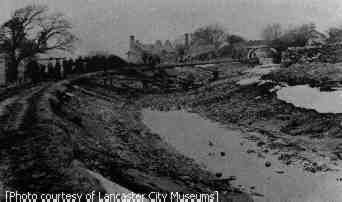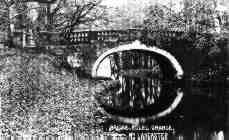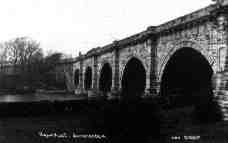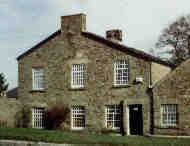![]()
Construction began late in 1792, in line with Rennie's specifications of a broad canal. Work was carried out by groups of workers known as navigators, or "navvies", who came from all over the country as well as from Ireland to work on the canals. Tools were basic - spades, picks and barrows, with horses to help with carrying or pulling. The navvies were rough men who lived hard lives, and, when they arrived in any location, often struck fear
into the hearts of local people.
The men who built the canals worked an average of a ten hour day, unless overtime was required, and received two shillings and two pence (i.e. 11p), whilst a stone mason working alongside them might receive three shillings (i.e. 15p) per day.

Once the channel had been dug, it had to be lined to make it water-tight, and this was done with clay - known as puddle. Puddle was spread across the channel and then packed down hard - either by the feet of the navvies, or sometimes by driving cattle up and down the puddle until it was sufficiently compacted. Depending on what type of ground the canal was being built over, the puddle could be up to three feet thick.
Right: Navvies working to repair a breach in 1897, using exactly the same tools and methods of work as were the navvies who built the canal over a hundred years before.
[Photo courtesy of Lancaster Maritime Museum (Lancaster City Museums)]
The bridges along the Lancaster Canal were built to a standard design, except where the canal passed through a large estate, such as at Ellel Grange, where the land-owner insisted on having a bridge which he felt was in-keeping with the architectural style of his property. Where the canal crossed rivers and streams aqueducts were built, and these varied from small single span ones, like Stainton, to the splendour of the Lune Aqueduct at Lancaster.

Right: At Ellel Grange, the standard design Rennie bridge embellished with a parapet to match the style of the estate
The Lune Aqueduct is the most out-standing feature of the Lancaster Canal. Designed by John Rennie, it is often claimed to be his best work. Construction began in January 1794, and by July there were some 150 men working on it night and day.

The structure is six hundred feet long and some sixty feet high, with five semi-circular arches supported by huge pillars. Along its top is a deep cornice and balustrades along the parapet. Its builder was a Scotsman, named Alexander Stevens, who died before it reached completion, and the work on the aqueduct was finished by his son.
Left: Rennie's masterpiece the magnificent aqueduct over the river Lune at Lancaster
The channel across the aqueduct is semi-circular, and lined with stone over a clay puddle lining said to be a yard thick. The bottom of the channel is some seven or eight feet below the level of the towpath, and contains a plug which could apparently be pulled to allow the aqueduct to be drained into the river to allow repairs to be undertaken. The aqueduct was completed by autumn 1797, at a total cost of £48,320.18s.10d.

For the canal to operate successfully it was necessary to construct other structures, such as wharves for loading freight, stables for the horses which pulled the boats, storage warehouses, as well as houses for lock-keepers, bank-rangers, wharfingers and other company employees.
Right: The former black-smith's shop at Lancaster waterway yard, later used as offices by BW, and now due for re-devopment
Copyright: Canalcaholic 1999
Last revised: August 2004